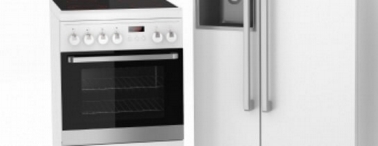
If you are planning a kitchen remodeling renovation project, chances are it involves at least one major kitchen appliance. Modern, state-of-the-art kitchen appliances offer many cutting edge innovations in their design feature. Programmable digital touch-control features, sleek stainless steel construction, and one-piece heating surfaces using space-age materials with heating elements built inside are common on today's market.
Perhaps your kitchen renovation plan involves a laundry closet or laundry area as part of your new kitchen floor plan. You may want to include a built in kitchen appliance, such as a separate convection oven or a microwave. At any rate, today's major appliances come with major power demands. Special attention is required to meet stringent building code requirements for electrical service.
How to Figure Appliance Requirements
Of all major appliances, electric ranges require the highest amount of electrical current. Older homes undergoing a kitchen remodeling renovation project may not have an adequate circuit to handle a 50 amp appliance. Figuring out the necessary amperage requirement for a circuit can be done by dividing the voltage (either 120v or 240v) by the total number of wattage connected to the circuit. For example, if you have a circuit sum of 2400 watts on a 120 volt circuit, the circuit needs to be at least 20 amps. (2400 % 120 = 20) Most electric ranges require 50 amp 120/240 volt circuits, electric dryers 120/240 volt 20 or 30 amps, electric water heaters 240 volt 20 or 30 amps, microwaves, refrigerators, dishwashers, clothes washers, and gas dryers are each usually 15 or 20 amps at 120 volts, and window air conditioners 15 amps at 120 volts or 30 amps at 240 volts.
Things to Consider when Updating a Circuit
While installing or updating a circuit for a kitchen appliance outlet is a relatively simple home improvement project, there are requirements that must be met. Wire “gauge†determines how heavy the wire is. The smaller the number, the heavier gauge wire. For instance, #6 gauge is much heavier than #12 gauge. Typically, a 50 amp circuit requires a minimum of #6 gauge wire for the hot wires, (red and black,) and a minimum of #8 gauge for neutral wires (white.) A 30 amp circuit would require a minimum of #10 gauge wire for all; #12 gauge wire is the minimum requirement for 15 and 20 amp circuits. Each size circuit (i.e. 30 amp or 50 amp, 120 volt or 240 volt) has its own style plug and outlet receptacle. This is to help avoid plugging a 50 amp appliance into a smaller size circuit. All receptacle types are commonly available at kitchen appliance stores.
Getting the Job Done Right
In most localities, wiring and outlets for a large kitchen appliance can be done by a DIY electrical amateur, as long as a licensed electrical contractor inspects and approves the work. But, if this sounds too technical, you may want to contract the services of a licensed electrician to install it for you. An increasingly popular and convenient way to find a reliable electrical contractor in your community is at TrustedPros.ca. Post your kitchen appliance installation project on line absolutely free, with no obligation. Electrical service professionals in your area are ready to provide competitive bids today. To complete your project, and shed a little light on the ins and outs of new major appliance circuitry.
To locate a reliable electrician, post your project online for free and receive bids from professionals in your area, ready to compete for your business.
Posted by: TrustedPros





